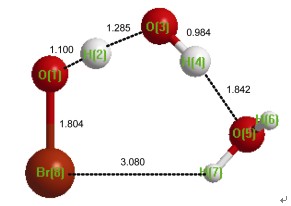| [1] Ge, M.-F.; Ma, C.-P. Prog. Chem. 2009, 21, 307. (葛茂发, 马春平, 化学进展, 2009, 21, 307.) [2] Platt, U.; Hönninger, G. Chemosphere 2003, 52, 325. [3] Peters, C.; Pechtl, S.; Stutz, J.; Hebestreit, K.; Hönninger, G.; Heumann, K. G.; Schwarz, A.; Winterlik, J.; Platt, U. Atmos. Chem. Phys. 2005, 5, 3357. [4] Zeng, X.-Q.; Wang, D.-X. Sci. China Ser. B-Chem. 2007, 37, 209. (曾小庆, 王殿勋, 中国科学B辑: 化学, 2007, 37, 209.) [5] Qiao, Z.; Sun, S.; Sun, Q.; Zhao, J.; Wang, D. J. Chem. Phys. 2003, 119, 7111. [6] Montzka, S. A.; Butler, J. H.; Myers, R. C.; Thompson, T. M.; Swanson, T. H.; Clarke, A. D.; Lock, L. T.; Elkins, J. W. Science 1996, 272, 1318. [7] Fan, H.-M.; Li, X.-Y.; Meng, L.-P.; Zheng, S.-J.; Zeng, Y.-L. Acta Chim. Sinica 2007, 65, 395. (樊红敏, 李晓艳, 孟令鹏, 郑世钧, 曾艳丽, 化学学报, 2007, 65, 395.) [8] Bedjanian, Y.; Poulet, G. Chem. Rev. 2003, 103, 4639. [9] Kukui, A.; Kirchner, U.; Benter, T.; Schindler, R. N. Ber. Bunsen-Ges. Phys. Chem. 1996, 100, 455. [10] Wang, L.; Liu, J.-Y.; Li, Z.-S.; Sun, C.-C. J. Comput. Chem. 2004, 25, 558. [11] Vöhringer-Martinez, E.; Hansmann, B.; Hernandez, H.; Francisco, J. S.; Troe, J.; Abel, B. Science 2007, 315, 497. [12] Anglada, J. M.; Gonzalez, J. ChemPhysChem 2009, 10, 3034. [13] Vaida, V.; Headrick, J. E. J. Phys. Chem. A 2000, 104, 5401. [14] Aloisio, S.; Francisco, J. S. Acc. Chem. Res. 2000, 33, 825. [15] Sennikov, P.-G.; Ignatov, S. K.; Schrems, O. ChemPhysChem 2005, 6, 392. [16] Vaida, V.; Kjaergaard, H. G.; Feierabend, K. J. Int. Rev. Phys. Chem. 2003, 22, 203. [17] Galano, A.; Narciso-Lopez, M.; Francisco-Marquez, M. J. Phys. Chem. A 2010, 114, 5796. [18] Vaida,V. J. Chem. Phys. 2011, 135, 020901. [19] Buszek, R. J.; Francisco, J. S.; Anglada, J. M. Int. Rev. Phys. Chem. 2011, 30, 335. [20] Jørgensen, S.; Kjaergaard, H. G. J. Phys. Chem. A 2010, 114, 4857. [21] Chen, H.-T.; Chang, J.-G.; Chen, H.-L. J. Phys. Chem. A 2008, 112, 8093. [22] Phillips, D. L.; Zhao, C.-Y.; Wang, D.-Q. J. Phys. Chem. A 2005, 109, 9653. [23] Gonzalez, J.; Anglada, J. M.; Buszek, R. J.; Francisco, J. S. J. Am. Chem. Soc. 2011, 133, 3345. [24] Njegic, B.; Raff, J. D.; Finlayson-Pitts, B. J.; Gordon, M. S.; Gerber, R. B. J. Phys. Chem. A 2010, 114, 4609. [25] Long, B.; Tan, X.-F.; Ren, D.-S.; Zhang, W.-J. J. Mol. Struct. Theochem. 2010, 956, 44. [26] Zhang, T. L.; Wang, W. L.; Zhang, P.; Lü, J.; Zhang, Y. Phys. Chem. Chem. Phys. 2011, 13, 20794. [27] Buszek, R. J.; Torrent-Sucarrat, M.; Anglada, J. M.; Francisco, J. S. J. Phys. Chem. A 2012, 116, 5821. [28] Buszek, R. J.; Barker, J. R.; Francisco, J. S. J. Phys. Chem. A 2012, 116, 4712. [29] Long, B.; Zhang, W.-J.; Long, Z.-W. Chin. J. Chem. Phys. 2011, 24, 419. [30] Gonzalez, J.; Anglada, J. M. J. Phys. Chem. A 2010, 114, 9151. [31] Medeiros, D. J.; Pimentel, A. S. J. Phys. Chem. A 2011, 115, 6357. [32] Long, B.; Tan, X.-F.; Long, Z.-W.; Wang, Y.-B.; Ren, D.-S.; Zhang, W.-J. J. Phys. Chem. A 2011, 115, 6559. [33] Long, B.; Zhang, W.-J.; Tan, X.-F.; Long, Z.-W.; Wang, Y.-B.; Ren, D.-S. Comput. Theor. Chem. 2011, 964, 248. [34] Xu, X.; Goddard, W. A. Proc. Natl. Acad. Sci. U. S. A. 2002, 99, 15308. [35] Xu, X.; Muller, R. P.; Goddard, W. A. Proc. Natl. Acad. Sci. U. S. A. 2002, 99, 3376. [36] Long, B.; Tan, X.-F.; Ren, D.-S.; Zhang, W.-J. Chem. Phys. Lett. 2010, 492, 214. [37] Vaida, V.; Kjaergaard, H. G.; Hintzel, P. E.; Donaldson, D. J. Science 2003, 299, 1566. [38] Long, B.; Zhang, W.-J.; Tan, X.-F.; Long, Z.-W.; Wang, Y.-B.; Ren, D.-S. J. Phys. Chem. A 2011, 115, 1350. [39] Iuga, C.; Alvarez-Idaboy, J. R.; Reyes, L.; Vivier-Bunge, A. J. Phys. Chem. Lett. 2010, 1, 3112. [40] Luo, Y.; Maeda, S.; Ohno, K. Chem. Phys. Lett. 2009, 469, 57. [41] Zhao, Y.-F.; Yang, Y.; Charles, M.; Charles, H. F. P.; Li, J.; Mei, D. H. J. Catal. 2011, 281, 199. [42] Chang, C.-R.; Wang, Y.-G.; Li, J. Nano Res. 2011, 4, 131. [43] Jørgensen, S.; Gross, A. J. Phys. Chem. A 2009, 113, 10284. [44] Duncan, W. T.; Bell, R. L.; Truong, T. N. J. Comput. Chem. 1998, 19, 1039. [45] Lu, Y.-X.; Wang, W.-L.; Wang, W.-N.; Liu, Y.-Y.; Zhang, Y. Acta Chim. Sinica 2010, 68, 1253. (卢彦霞, 王文亮, 王渭娜, 刘英英, 张越, 化学学报, 2010, 68, 1253.)[46] Zheng, Y.; Zhu, Q.; Li, Z.-R.; Li, X.-Y. Acta Chim. Sinica 2013, 71, 81. (郑洋, 朱权, 李泽荣, 李象远, 化学学报, 2013, 71, 81.) |
